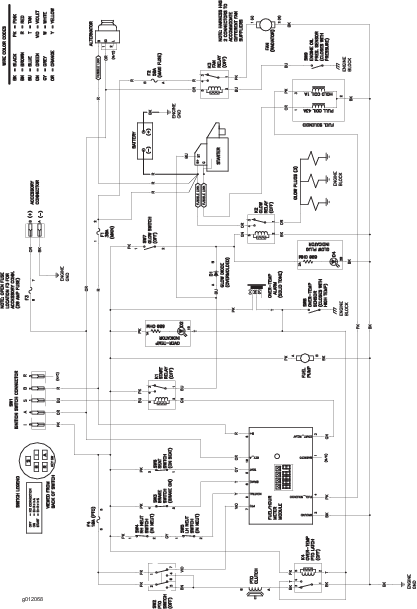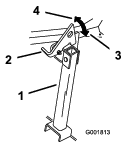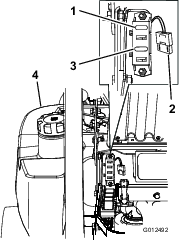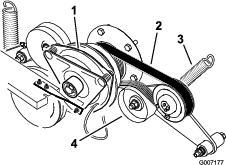| Maintenance Service Interval | Maintenance Procedure |
|---|---|
| Before each use or daily |
|
Introduction
This rotary-blade, riding lawn mower is intended to be used by residential homeowners or professional, hired operators. It is designed primarily for cutting grass on well-maintained lawns on residential or commercial properties. It is not designed for cutting brush or for agricultural uses.
Read this information carefully to learn how to operate and maintain your product properly and to avoid injury and product damage. You are responsible for operating the product properly and safely.
You may contact Toro directly at www.Toro.com for product safety and operation training materials, accessory information, help finding a dealer, or to register your product.
Whenever you need service, genuine Toro parts, or additional information, contact an Authorized Service Dealer or Toro Customer Service and have the model and serial numbers of your product ready. Figure 1 identifies the location of the model and serial numbers on the product. Write the numbers in the space provided.
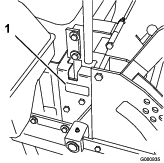
This manual identifies potential hazards and has safety messages identified by the safety-alert symbol (Figure 2), which signals a hazard that may cause serious injury or death if you do not follow the recommended precautions.

This manual uses 2 words to highlight information. Important calls attention to special mechanical information and Note emphasizes general information worthy of special attention.
This product complies with all relevant European directives; for details, please see the separate product specific Declaration of Conformity (DOC) sheet.
Safety
This machine was designed in accordance with EN ISO 5395:2013.
Improper use or maintenance by the operator or owner can result in injury. To reduce the potential for injury, comply with these safety instructions and always pay attention to the safety-alert symbol, which means Caution, Warning, or Danger— ”personal safety instruction”. Failure to comply with the instruction may result in personal injury or death.
Safe Operating Practices
This product is capable of amputating hands and feet and throwing objects. Always follow all safety instructions to avoid serious injury or death.
Training
-
Read the instructions carefully. Be familiar with the controls and the proper use of the equipment.
-
Never allow children or people unfamiliar with these instructions to use the lawnmower. Local regulations can restrict the age of the operator.
-
Never mow while people, especially children, or pets are nearby.
-
Keep in mind that the operator or user is responsible for accidents or hazards occurring to other people or their property.
-
Do not carry passengers.
-
All drivers should seek and obtain professional and practical instruction. Such instruction should emphasize:
-
the need for care and concentration when working with ride-on machines;
-
control of a ride-on machine sliding on a slope will not be regained by the application of the control levers. The main reasons for loss of control are:
-
insufficient wheel grip, especially on wet grass;
-
being driven too fast;
-
inadequate braking;
-
the type of machine is unsuitable for its task;
-
lack of awareness of the effect of ground conditions, especially slopes;
-
incorrect hitching and load distribution.
-
-
Preparation
-
While mowing, always wear substantial, slip-resistant footwear and long trousers.
-
Thoroughly inspect the area where the equipment is to be used and remove all objects which may be thrown by the machine.
-
Warning–Fuel is highly flammable.
-
Store fuel in containers specifically designed for this purpose.
-
Refuel outdoors only and do not smoke while refuelling.
-
Add fuel before starting the engine. Never remove the cap of the fuel tank or add fuel while the engine is running or when the engine is hot.
-
If fuel is spilled, do not attempt to start the engine but move the machine away from the area of spillage and avoid creating any source of ignition until fuel vapors have dissipated.
-
Replace all fuel tanks and container caps securely.
-
-
Replace faulty silencers.
-
Before using, always visually inspect to see that the blades, blade bolts and cutter assembly are not worn or damaged. Replace worn or damaged blades and bolts in sets to preserve balance.
-
On multi-bladed machines, take care as rotating one blade can cause other blades to rotate.
Operation
-
Lightning can cause severe injury or death. If lightning is seen or thunder is heard in the area, do not operate the machine; seek shelter.
-
Be alert, slow down and use caution when making turns. Look behind and to the side before changing directions.
-
Do not operate the engine in a confined space where dangerous carbon monoxide fumes can collect.
-
Mow only in daylight or in good artificial light.
-
Before attempting to start the engine, disengage all blade attachment clutches and shift into neutral.
-
Do not use on slopes greater than 15 degrees.
-
Remember there is no such thing as a safe slope. Travel on grass slopes requires particular care. To guard against overturning:
-
do not stop or start suddenly when on a slope;
-
use slow speeds on slopes and during tight turns;
-
stay alert for humps and hollows and other hidden hazards;
-
-
Use care when pulling loads or using heavy equipment.
-
Use only approved drawbar hitch points.
-
Limit loads to those you can safely control.
-
Do not turn sharply. Use care when reversing.
-
-
Watch out for traffic when crossing or near roadways.
-
Stop the blades rotating before crossing surfaces other than grass.
-
When using any attachments, never direct discharge of material toward bystanders nor allow anyone near the machine while in operation.
-
Never operate the machine with damaged guards or without safety protective devices in place.
-
Do not change the engine governor settings or overspeed the engine. Operating the engine at excessive speed can increase the hazard of personal injury.
-
Before leaving the operator's position:
-
disengage the power takeoff and lower the attachments;
-
change into neutral and set the parking brake;
-
shut off the engine and remove the key.
-
-
Disengage drive to attachments, shut off the engine, and disconnect the spark plug wire(s) or remove the ignition key
-
before clearing blockages or unclogging chute;
-
before checking, cleaning or working on the lawnmower;
-
after striking a foreign object. Inspect the lawnmower for damage and make repairs before restarting and operating the equipment; if the machine starts to vibrate abnormally (check immediately).
-
-
Disengage drive to attachments when transporting or not in use.
-
Shut off the engine and disengage drive to attachment
-
before refuelling;
-
before removing the grass catcher;
-
before making height adjustment unless adjustment can be made from the operator's position.
-
-
Reduce the throttle setting during engine run-out and, if the engine is provided with a shutoff valve, turn the fuel off at the conclusion of mowing.
Maintenance and Storage
-
Keep all nuts, bolts, and screws tight to be sure the equipment is in safe working condition.
-
Never store the equipment with fuel in the tank inside a building where fumes can reach an open flame or spark.
-
Allow the engine to cool before storing in any enclosure.
-
To reduce the fire hazard, keep the engine, silencer, battery compartment and fuel storage area free of grass, leaves, or excessive grease.
-
Check the grass catcher frequently for wear or deterioration.
-
Replace worn or damaged parts for safety.
-
If you must drain the fuel tank, this should be done outdoors.
-
On multi-bladed machines, take care as rotating 1 blade can cause other blades to rotate.
-
When machine is to be parked, stored or left unattended, lower the cutting means unless a positive mechanical lock is used.
Toro Riding Mower Safety
The following list contains safety information specific to Toro products or other safety information that you must know that is not included in the CEN standard.
-
Engine exhaust contains carbon monoxide, which is an odorless, deadly poison that can kill you. Do not run engine indoors or in an enclosed area.
-
Keep your hands, feet, hair and loose clothing away from attachment discharge area, underside of mower and any moving parts while engine is running.
-
Do not touch equipment or attachment parts which may be hot from operation. Allow to cool before attempting to maintain, adjust, or service.
-
Battery acid is poisonous and can cause burns. Avoid contact with skin, eyes and clothing. Protect your face, eyes, and clothing when working with a battery.
-
Battery gases can explode. Keep cigarettes, sparks and flames away from battery.
-
Use only genuine Toro replacement parts to ensure that original standards are maintained.
-
Use only Toro-approved attachments. Warranty may be voided if used with unapproved attachments.
Slope Operation
-
Do not mow slopes greater than 15 degrees.
-
Do not mow near drop-offs, ditches, steep banks or water. Wheels dropping over edges can cause rollovers, which may result in serious injury, death or drowning.
-
Do not mow slopes when grass is wet. Slippery conditions reduce traction and could cause sliding and loss of control.
-
Do not make sudden turns or rapid speed changes.
-
Use a walk behind mower and/or a hand trimmer near drop-offs, ditches, steep banks or water.
-
Reduce speed and use extreme caution on slopes.
-
Remove or mark obstacles such as rocks, tree limbs, etc. from the mowing area. Tall grass can hide obstacles.
-
Watch for ditches, holes, rocks, dips, and rises that change the operating angle, as rough terrain could overturn the machine.
-
Avoid sudden starts when mowing uphill because the mower may tip backwards.
-
Be aware that loss of traction may occur going downhill. Weight transfer to the front wheels may cause drive wheels to slip and cause loss of braking and steering.
-
Always avoid sudden starting or stopping on a slope. If tires lose traction, disengage the blades and proceed slowly off the slope.
-
Follow the manufacturer's recommendations for wheel weights or counterweights to improve stability.
-
Use extreme care with grass catchers or other attachments. These can change the stability of the machine and cause loss of control.
Sound Pressure Level
This unit has a sound pressure level at the operator’s ear of 90 dBA, which includes an Uncertainty Value (K) of 1 dBA.
The sound pressure level was determined according to the procedures outlined in EN ISO 5395:2013.
Sound Power Level
This unit has a guaranteed sound power level of 105 dBA, which includes an Uncertainty Value (K) of 1 dBA.
The sound power level was determined according to the procedures outlined in ISO 11094.
Vibration Level
Hand-Arm
Measured vibration level for right hand = 3.1 m/s2
Measured vibration level for left hand = 3.1 m/s2
Uncertainty Value (K) = 1.6 m/s2
Measured values were determined according to the procedures outlined in EN ISO 5395:2013.
Whole Body
Measured vibration level = 0.90 m/s2
Uncertainty Value (K) = 0.45 m/s2
Measured values were determined according to the procedures outlined in EN ISO 5395:2013.
Safety and Instructional Decals
 |
Safety decals and instructions are easily visible to the operator and are located near any area of potential danger. Replace any decal that is damaged or lost. |



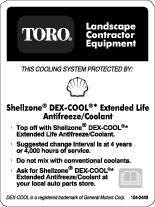
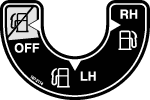


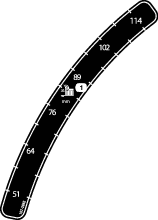



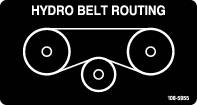
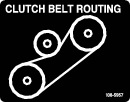
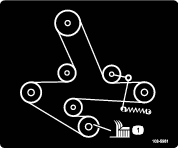
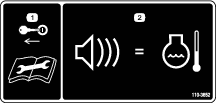

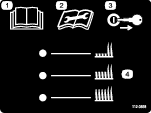

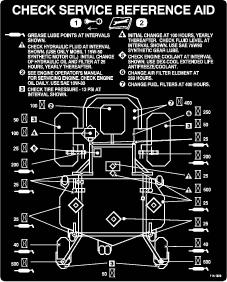

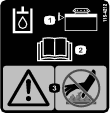
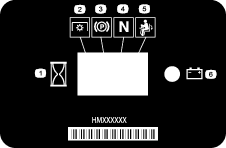
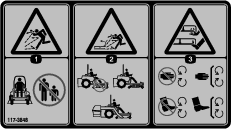

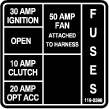
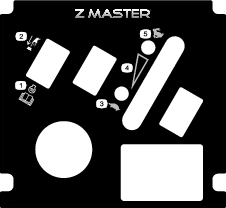





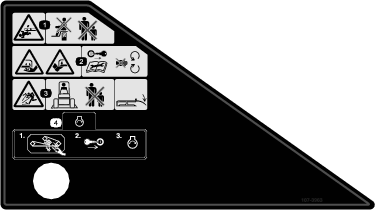
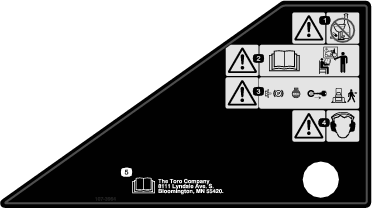

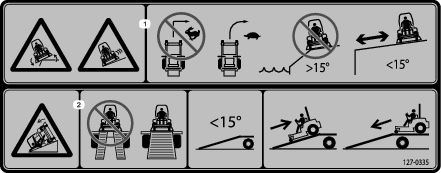
Product Overview

Become familiar with all the controls before you start the engine and operate the machine (Figure 3 and Figure 4).
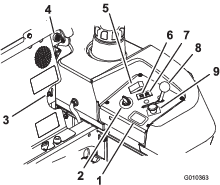
Hour Meter
The hour meter records the number of hours the engine has operated. It operates when the engine is running. Use these times for scheduling regular maintenance (Figure 4).
Safety-Interlock Indicators
There are symbols on the hour meter and they indicate with a black triangle that the interlock component is in the correct position (Figure 5).
Battery Indicator Light
When the ignition key is initially turned to the RUN position for a few seconds, the battery voltage is displayed in the area where the hours are normally displayed.
The battery light turns on when the ignition is turned on and when the charge is below the correct operating level (Figure 5).
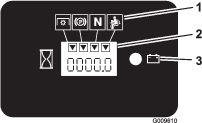
Throttle Control
The throttle control is variable between FAST and SLOW.
Blade-Control Switch (PTO)
The blade-control switch (PTO) is used to engage the electric clutch to drive the mower blades with the motion-control levers in the center, unlocked position. Pull the switch up to engage the blades and release. To disengage the blades, push the blade-control switch (PTO) down.
Neutral-Lock Position
The NEUTRAL-LOCK position is used with the safety-interlock system and to determine NEUTRAL position.
Ignition Switch
This switch is used to start the mower engine and has 3 positions: START, RUN, and OFF.
Glow-Plug Light
The glow plug indicator light turns on when the glow-plug button is engaged (Figure 4).
Glow-Plug Switch
This switch activates the glow plugs and is indicated by the glow-plug light. Hold down the glow-plug switch for 10 seconds prior to starting.
Engine-Temperature Light
The engine-temperature light comes on when the engine is over heating (Figure 4).
Audible Alarm
This machine has an audible alarm that alerts the user to turn off the engine or engine damage can occur from overheating. Refer to Servicing the Cooling System in Cooling System Maintenance.
Fuel-Selector Valve
The fuel-selector valve is located behind the seat.
Close the fuel-selector valve when transporting or storing mower.
Move the selector valve to the left or right position for operation.
Attachments/Accessories
A selection of Toro approved attachments and accessories is available for use with the machine to enhance and expand its capabilities. Contact your Authorized Service Dealer or Distributor or go to www.Toro.com for a list of all approved attachments and accessories.
To best protect your investment and maintain optimal performance of your Toro equipment, count on Toro genuine parts. When it comes to reliability, Toro delivers replacement parts designed to the exact engineering specification of our equipment. For peace of mind, insist on Toro genuine parts.
Operation
Note: Determine the left and right sides of the machine from the normal operating position.
Adding Fuel
The engine runs on clean, fresh diesel fuel with a minimum octane rating of 40. Purchase fuel in quantities that you can use within 30 days to ensure fuel freshness.
Use summer grade diesel fuel (No. 2-D) at temperatures above -7°C (20°F) and winter grade diesel fuel (No. 1-D or No. 1-D/2-D blend) below -7°C (20°F). Use of winter grade diesel fuel at lower temperatures provides lower flash point and pour point characteristics, therefore easing startability and lessening chances of chemical separation of the fuel due to lower temperatures (wax appearance, which may plug filters).
Use of summer grade diesel fuel above -7°C (20°F) contributes toward longer life of the pump components.
Important: Do not use kerosene or gasoline instead of diesel fuel. Failure to observe this caution will damage the engine.
Warning
Fuel is harmful or fatal if swallowed. Long-term exposure to vapors can cause serious injury and illness.
-
Avoid prolonged breathing of vapors.
-
Keep face away from nozzle and fuel tank or conditioner opening.
-
Keep fuel away from eyes and skin.
Danger
In certain conditions, fuel is extremely flammable and highly explosive. A fire or explosion from fuel can burn you and others and can damage property.
-
Fill the fuel tank outdoors on level ground, in an open area, when the engine is cold. Wipe up any fuel that spills.
-
Never fill the fuel tank inside an enclosed trailer.
-
Do not fill the fuel tank completely full. Fill the fuel tank to the bottom of the filler neck. The empty space in the tank allows fuel to expand. Overfilling may result in fuel leakage or damage to the engine or emission system (if equipped).
-
Never smoke when handling fuel, and stay away from an open flame or where fuel fumes may be ignited by a spark.
-
Store fuel in an approved container and keep it out of the reach of children. Never buy more than a 30-day supply of fuel.
-
Always place fuel containers on the ground away from your vehicle before filling.
-
Do not fill fuel containers inside a vehicle or on a truck or trailer bed because interior carpets or plastic truck bed liners may insulate the container and slow the loss of any static charge.
-
When practical, remove fuel-powered equipment from the truck or trailer and refuel the equipment with its wheels on the ground.
-
If this is not possible, then refuel such equipment on a truck or trailer from a portable container, rather than from a fuel-dispenser nozzle.
-
If a fuel-dispenser nozzle must be used, keep the nozzle in contact with the rim of the fuel tank or container opening at all times until fueling is complete.
Biodiesel Ready
This machine can also use a biodiesel blended fuel of up to B20 (20% biodiesel, 80% petrodiesel). The petrodiesel portion should be low or ultra low sulfur.
Observe the following precautions:
-
The biodiesel portion of the fuel meet specification ASTM D6751 or EN14214.
-
The blended fuel composition should meet ASTM D975 or EN590.
-
Painted surfaces may be damaged by biodiesel blends.
-
Use B5 (biodiesel contend of 5%) or lesser blend in cold weather.
-
Monitor seals, hoses, gaskets in contact with fuel as they may degrade over time.
-
Fuel filter plugging may be expected for a time after converting to biodiesel blends.
-
Contact your distributor if you wish for more information on biodiesel.
Filling the Fuel Tank
Note: Do not fill the fuel tank completely full. Fill the fuel tank to the bottom of the filler neck. The empty space in the tank allows the gasoline to expand.
-
Shut the engine off and set the parking brake.
-
Clean around each fuel-tank cap and remove the cap. Fill the fuel tank to the bottom of the filler neck. This space in the tank allows the fuel to expand. Do not fill the fuel tank completely full.
-
Install the fuel-tank cap securely. Wipe up any fuel that may have spilled.
-
If possible, fill the fuel tank after each use. This minimizes possible buildup of condensation inside the fuel tank.
Checking the Engine-Oil Level
Before you start the engine and use the machine, check the oil level in the engine crankcase; refer to Checking the Engine-Oil Level.
Switching the Fuel Tanks
Important: Do not run the machine out of fuel. This may cause engine damage and require the fuel system to be checked.
The fuel-selector valve is located behind the left side of the seat.
The unit has 2 fuel tanks. One tank is on the left side and the other on the right side. Each tank connects to the fuel-selector valve. From there a common fuel line leads to the engine (Figure 6).
To use the left side fuel tank rotate the fuel-selector valve to the left-hand location. To use the right side fuel tank rotate the fuel-selector valve to the right-hand location (Figure 6)
Close the fuel-selector valve before transporting or storing machine.
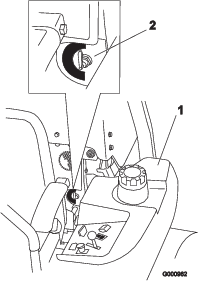
Using the Rollover Protection System (ROPS)
Warning
To avoid injury or death from rollover: keep the roll bar in the raised locked position and use the seat belt.
Ensure that the rear part of the seat is secured with the seat latch.
Warning
There is no rollover protection when the roll bar is in the down position.
-
Lower the roll bar only when absolutely necessary.
-
Do not wear the seat belt when the roll bar is in the down position.
-
Drive slowly and carefully.
-
Raise the roll bar as soon as clearance permits.
-
Check carefully for overhead clearances (i.e., branches, doorways, electrical wires) before driving under any objects and do not contact them.
-
Remove the hairpin cotters and remove the 2 pins (Figure 8).
-
Lower the roll bar to the down position. There are 2 down positions. See Figure 7 for the positions.
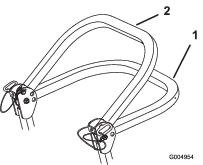
-
Install the 2 pins and secure them with the hairpin cotters (Figure 8).
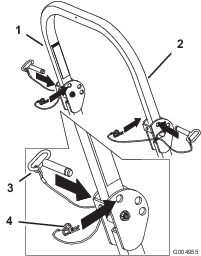
-
To raise the roll bar, remove the hairpin cotters and remove the 2 pins (Figure 8).
-
Raise the roll bar to the upright position and install the 2 pins and secure them with the hairpin cotters (Figure 8).
Think Safety First
Please read all safety instructions and symbols in the safety section. Knowing this information could help you or bystanders avoid injury.
Danger
Operating the machine on wet grass or steep slopes can cause sliding and loss of control.
-
Do not operate on slopes greater than 15 degrees.
-
Reduce speed and use extreme caution on slopes.
-
Do not operate the machine near water.
Danger
Wheels dropping over edges can cause rollovers, which may result in serious injury, death, or drowning.
Do not operate the machine near drop-offs.
Danger
Operating the machine while the roll bar is down may lead to serious injury or death in the event of a rollover.
Always keep the roll bar in the fully raised and locked position and use the seat belt.
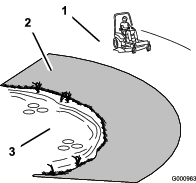
Caution
This machine produces sound levels in excess of 85 dBA at the operators ear and can cause hearing loss through extended periods of exposure.
Wear hearing protection when operating this machine.
Wear protective equipment for your eyes, ears, hands, feet, and head when using this machine.

Operating the Parking Brake
Always set the parking brake when you stop the machine or leave it unattended.
Setting the Parking Brake
-
Move the motion-control levers (Figure 17) out to the NEUTRAL-LOCK position.
-
Pull up and back on the parking-brake lever to set the parking brake (Figure 11). The parking-brake lever should stay firmly in the engaged position.
Warning
Parking brake may not hold machine parked on a slope and could cause personal injury or property damage.
Do not park on slopes unless wheels are chocked or blocked
Releasing the Parking Brake
Push forward and down on the parking-brake lever to release the parking brake (Figure 11). The parking brake is disengaged and the lever will rest against the brake stop.
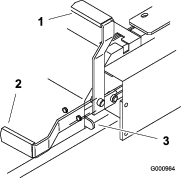
Starting and Stopping the Engine
Starting the Engine in Normal Weather
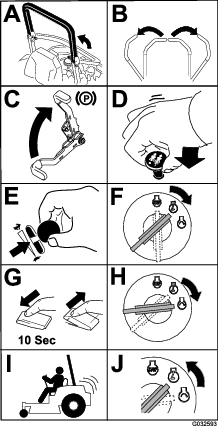
Important: Use starting cycles of no more than 30 seconds per minute to avoid overheating the starter motor.
Note: Additional starting cycles may be required when starting the engine for the first time after the fuel system has been completely without fuel.
Starting the Engine in Cold Weather (Below -5°C or 23°F)
Note: Use the correct engine oil for the starting temperature; refer to Servicing the Engine Oil.
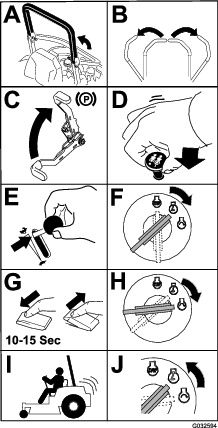
Important: Use starting cycles of no more than 30 seconds per minute to avoid overheating the starter motor.
Note: Do not use fuel left over from the summer. Use only fresh winter grade diesel fuel.
Stopping the Engine
Caution
Children or bystanders may be injured if they move or attempt to operate the machine while it is unattended.
Always remove the ignition key and set the parking brake when leaving the machine unattended, even if just for a few minutes.

Important: Make sure that you close the fuel-shutoff valve before transporting or storing the machine, as fuel leakage may occur. Set the parking brake before transporting the machine. Make sure that you remove the key as the fuel pump may run and cause the battery to lose charge.
Operating the Power Takeoff (PTO)
The power takeoff (PTO) switch starts and stops the mower blades and any powered attachments.
Engaging the PTO
-
If the engine is cold, allow the engine to warm up 5 to 10 minutes before engaging the PTO.
-
While seated in the seat, release the pressure on the traction control levers and place in NEUTRAL.
-
Place the throttle in the FAST position.
Note: Engaging the PTO with the throttle at the half or less position causes excessive wear to the drive belts.
-
Pull out on the power takeoff (PTO) switch to engage it (Figure 15).
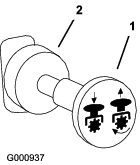
Disengaging the PTO
To disengage, push the PTO switch to the OFF position (Figure 15).
Using the Safety-Interlock System
Caution
If safety interlock switches are disconnected or damaged the machine could operate unexpectedly causing personal injury.
-
Do not tamper with the interlock switches.
-
Check the operation of the interlock switches daily and replace any damaged switches before operating the machine.
Understanding the Safety-Interlock System
The safety-interlock system is designed to prevent the engine from starting unless:
-
The parking brake is engaged.
-
The power takeoff (PTO) is disengaged.
-
The motion-control levers are in the NEUTRAL-LOCK position
The safety-interlock system also is designed to shut off the engine when the traction controls are moved from the LOCKED position with the parking brake engaged or if you rise from the seat when the PTO is engaged.
The hour meter has symbols to notify the user when the interlock component is in the correct position. When the component is in the correct position, a triangle lights up in the corresponding square.
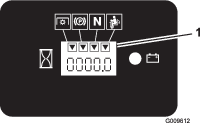
Testing the Safety-Interlock System
If the safety system does not operate as described below, have an Authorized Service Dealer repair the safety system immediately.
-
Sitting on the seat, engage the parking brake and move the PTO to ON. Try starting the engine; the engine should not crank.
-
Sitting on the seat, engage the parking brake and move the PTO to OFF. Move either motion-control lever (out of the NEUTRAL-LOCK position). Try starting the engine; the engine should not crank. Repeat for other control lever.
-
Sitting on the seat, engage the parking brake, move the PTO switch to OFF and move the motion-control levers to the NEUTRAL-LOCK position. Now start the engine. While the engine is running, release the parking brake, engage the PTO and rise slightly from the seat; the engine should stop.
-
Sitting on the seat, engage the parking brake, move the PTO switch to OFF and move the motion-control levers to the NEUTRAL-LOCK position. Now start the engine. While the engine is running, center either motion control and move (forward or reverse); the engine should stop. Repeat for the other motion control.
-
Sitting on the seat, disengage the parking brake, move the PTO switch to OFF and move the motion-control levers to NEUTRAL-LOCK position. Try starting the engine; the engine should not crank.
Driving Forward or Backward
The throttle control regulates the engine speed as measured in rpm (revolutions per minute). Place the throttle control in the FAST position for best performance. Always operate in the FULL THROTTLE position when mowing.
Caution
Machine can spin very rapidly. Operator may lose control of machine and cause personal injury or damage to machine.
-
Use caution when making turns.
-
Slow the machine down before making sharp turns.
Driving Forward
-
Release the parking brake; refer to Adjusting the Parking Brake.
-
Move the levers to the center, unlocked position.
-
To go forward, slowly push the motion-control levers forward (Figure 17).
Note: The engine kills if the traction control levers are moved with the parking brake engaged.
To go straight, apply equal pressure to both motion-control levers (Figure 17).
To turn, move the motion-control lever toward neutral in the direction you want to turn (Figure 17).
The farther you move the traction control levers in either direction, the faster the machine moves in that direction.
To stop, pull the motion-control levers to the NEUTRAL position.
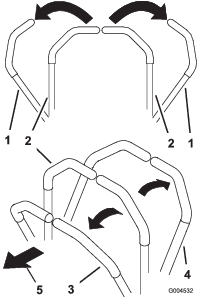
Driving Backward
-
Move the levers to the center, unlocked position.
-
To go backward, slowly pull the motion-control levers rearward (Figure 17).
To go straight, apply equal pressure to both motion-control levers (Figure 17).
To turn, release pressure on the motion-control lever toward the direction you want to turn (Figure 17).
To stop, push the motion-control levers to the NEUTRAL position.
Stopping the Machine
To stop the machine, move the traction-control levers to the NEUTRAL position and then to the LOCKED position, disengage the power takeoff (PTO), and turn the ignition key to the OFF position.
Set the parking brake when you leave the machine. Remember to remove the key from the ignition switch.
Caution
Children or bystanders may be injured if they move or attempt to operate the machine while it is unattended.
Always remove the ignition key and set the parking brake when leaving the machine unattended, even if just for a few minutes.
Adjusting the Height-of-Cut
The height-of-cut is adjusted from 38 to 127 mm (1-1/2 to 5 inches) in 6 mm (1/4 inch) increments by relocating the pin into different hole locations.
-
Raise the height-of-cut lever to the TRANSPORT position (also the 127 mm (5 inch) cutting-height position) (Figure 18).
-
To adjust, remove the pin from the height-of-cut bracket (Figure 18).
-
Select a hole in the height-of-cut bracket corresponding to the height-of-cut desired and, insert the pin (Figure 18).
-
Move the lever to the selected height.
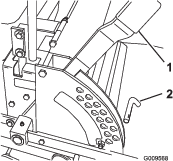
Adjusting the Anti-Scalp Rollers
Whenever you change the height-of-cut, it is recommended to adjust the height of the anti-scalp rollers.
-
Disengage the PTO, move the motion-control levers to the NEUTRAL-LOCK position, and set the parking brake.
-
Shut off the engine, remove the key, and wait for all moving parts to stop before leaving the operating position.
-
After adjusting the height of cut, adjust the rollers by removing the flange nut, bushing, spacer, and bolt (Figure 19 or Figure 20).
Note: The 2 middle rollers do not have a spacer (Figure 19 or Figure 20).
-
Select a hole so the anti-scalp roller is positioned to the nearest corresponding height-of-cut desired.
-
Install the flange nut bushing, spacer, and bolt. Torque to 54 to 61 N∙m (40 to 45 ft-lb) (Figure 19 or Figure 20).
-
Repeat this adjustment on the other anti-scalp rollers.

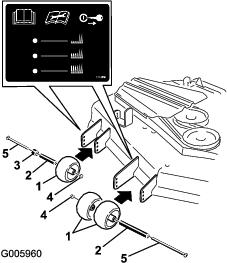
Positioning the Seat
The seat can move forward and backward. Position the seat where you have the best control of the machine and are most comfortable.
To adjust, move the lever sideways to unlock seat (Figure 21).
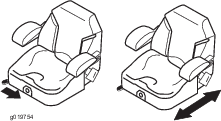
Changing the Seat Suspension
The seat is adjustable to provide a smooth and comfortable ride. Position the seat where you are most comfortable.
To adjust it, turn the knob in front either direction to provide the best comfort (Figure 22).
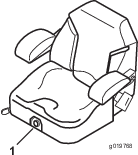
Unlatching the Seat
-
Move the seat to the most rearward position. This prevents interference when the seat is raised.
-
Push the seat latch rearward to unlatch the seat.
-
Raise the seat up. This allows access to the machine under the seat (Figure 23).

Pushing the Machine by Hand
Important: Always push the machine by hand. Never tow the machine because hydraulic damage may occur.
Pushing the Machine
-
Disengage the power takeoff (PTO) and turn the ignition key to off. Move the levers to NEUTRAL-LOCK position, apply the parking brake, and remove the key.
-
Rotate the bypass valves counterclockwise 1 turn. This allows hydraulic fluid to bypass the pump enabling the wheels to turn (Figure 24).
Important: Do not rotate the bypass valves more than 1 turn. This prevents valves from coming out of the body and causing fluid to run out.
-
Disengage parking brake before pushing the machine.
Changing to Machine Operation
Rotate the bypass valves clockwise 1 turn to operate the machine (Figure 24).
Note: Do not over tighten the by-pass valves.
The machine will not drive unless bypass valves are turned in.

Operating with the Overheat Sensor
This machine has a sensor that turns OFF the mower deck when the engine overheats. When the engine overheats, the audible alarm and light alarm turns ON along with the mower deck turning OFF.
If the mower deck turns OFF automatically because of overheating, drive the machine to a safe area and to a truck or trailer.
If the machine overheats, ensure that the area around the engine and radiator is clear of any debris. Turn the engine off and allow it to cool down before you engage the mower deck. If the engine continues to overheat, take your machine to an Authorized Service Dealer.
Transporting the Machine
Use a heavy-duty trailer or truck to transport the machine. Ensure that the trailer or truck has all necessary lighting and marking as required by law. Please carefully read all the safety instructions. Knowing this information could help you, your family, pets or bystanders avoid injury.
To transport the machine:
-
Lock the brake and block the wheels.
-
Securely fasten the machine to the trailer or truck with straps, chains, cable, or ropes.
-
Secure a trailer to the towing vehicle with safety chains.
Warning
Driving on the street or roadway without turn signals, lights, reflective markings, or a slow moving vehicle emblem is dangerous and can lead to accidents causing personal injury.
Do not drive machine on a public street or roadway.
Loading the Machine
Use extreme caution when loading or the unloading machine onto a trailer or a truck. Use a full-width ramp that is wider than the machine for this procedure. Back the machine up the ramp and drive it forward down the ramp (Figure 25).

Important: Do not use narrow individual ramps for each side of the machine.
Ensure that the ramp is long enough so that the angle with the ground does not exceed 15 degrees (Figure 26). On flat ground, this requires a ramp to be at least 4 times as long as the height of the trailer or truck bed to the ground. A steeper angle may cause mower components to get caught as the machine moves from the ramp to the trailer or truck. Steeper angles may also cause the machine to tip or lose control. If you are loading the machine on or near a slope, position the trailer or truck so that it is on the down side of the slope and the ramp extends up the slope. This minimizes the ramp angle.
Warning
Loading a machine onto a trailer or truck increases the possibility of tip-over and could cause serious injury or death.
-
Use extreme caution when operating a machine on a ramp.
-
Ensure that the ROPS is in the up position and use the seat belt when loading or unloading the machine. Ensure that the ROPS clears the top of an enclosed trailer.
-
Use only a full-width ramp; do not use individual ramps for each side of the machine.
-
Do not exceed a 15-degree angle between the ramp and the ground or between the ramp and the trailer or truck.
-
Ensure that the length of ramp is at least 4 times as long as the height of the trailer or truck bed to the ground. This ensures that ramp angle does not exceed 15 degrees on flat ground.
-
Back up ramps and drive forward down ramps.
-
Avoid sudden acceleration or deceleration while driving the machine on a ramp as this could cause a loss of control or a tip-over situation.
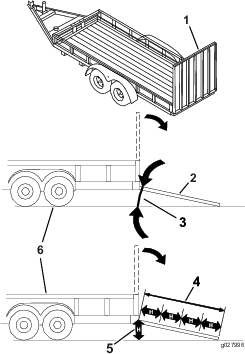
Using the Z Stand™
The Z Stand raises the front end of the machine to allow you to clean the mower and remove the blades.
Warning
The machine could fall onto someone and cause serious injury or death.
-
Use extreme caution when operating the machine on the Z Stand™.
-
Use only for cleaning the mower and removing the blades.
-
Do not keep the machine on the Z Stand™ for extended periods of time.
-
Always turn the engine off, set the parking brake, and remove the key before performing any maintenance to the mower.
Driving up onto the Z Stand™
Important: Use the Z Stand™ on a level surface.
-
Raise the mower to the TRANSPORT position.
-
Remove the bracket pin (Figure 27).

-
Raise the latch. Swing the stand foot out front and slide stand toward machine, into the bottom of slot (Figure 27 and Figure 28).
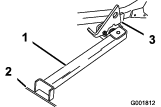
-
Set the foot of stand on the ground and rest the latch on the pivot tab (Figure 28).
-
Start the engine and put it at half throttle.
Note: For best results, place the foot of stand into seams in sidewalks or into the turf (Figure 28).
-
Drive onto the stand. Stop when the latch drops over the tab into the LOCKED position (Figure 28). Once onto the stand, engage the parking brake and turn off the engine.
-
Chock or block the drive wheels.
Warning
The parking brake may not hold machine parked on Z Stand™ and could cause personal injury or property damage.
Do not park on Z Stand™ unless wheels are chocked or blocked.
-
Perform the maintenance.
Operating Tips
Using the Fast Throttle Setting
For best mowing and maximum air circulation, operate the engine at the FAST throttle position. Air is required to thoroughly cut grass clippings, so do not set the height of cut so low as to totally surround the mower in uncut grass. Always try to have 1 side of the mower free from uncut grass, which allows air to be drawn into the mower.
Cutting a Lawn for the First Time
Cut the grass slightly longer than normal to ensure that the cutting height of the mower does not scalp any uneven ground. However, the cutting height you have used in the past is generally the best to use. When cutting grass longer than 15.24 cm (6 inches) tall, you may want to cut the lawn twice to ensure an acceptable quality of cut.
Cutting a Third of the Grass Blade
It is best to cut only about a third of the grass blade. Cutting more than that is not recommended unless grass is sparse, or it is late fall when grass grows more slowly.
Alternating the Mowing Direction
Alternate the mowing direction to keep the grass standing straight. This also helps disperse clippings, which enhances decomposition and fertilization.
Mowing at Correct Intervals
Normally, mow every 4 days. However, grass grows at different rates at different times. To maintain the same cutting height, which is a good practice, mow more often in early spring. As the grass growth rate slows in mid-summer, mow less frequently. If you cannot mow for an extended period, first mow at a high cutting height; then mow again 2 days later at a lower height setting.
Adjusting the Cutting Speed
To improve cut quality, use a slower ground speed in certain conditions.
Avoiding Cutting Too Low
If the cutting width of the mower is wider than the mower you previously used, raise the cutting height to ensure that uneven turf is not cut too short.
Cutting Long Grass
If the grass is ever allowed to grow slightly longer than normal, or if it contains a high degree of moisture, raise the cutting height higher than usual and cut the grass at this setting. Then cut the grass again using the lower, normal setting.
Stopping
If you must stop the forward motion of the machine while mowing, a clump of grass clippings may drop onto your lawn. To avoid this, move onto a previously cut area with the blades engaged.
Keeping the Underside of the Mower Clean
Clean clippings and dirt from the underside of the mower after each use. If grass and dirt build up inside the mower, cutting quality will eventually become unsatisfactory.
Maintaining the Blades
Maintain a sharp blade throughout the cutting season because a sharp blade cuts cleanly without tearing or shredding the grass blades. Tearing and shredding turns grass brown at the edges, which slows growth and increases the chance of disease. Check the cutter blades daily for sharpness, and for any wear or damage. File down any nicks and sharpen the blades as necessary. If a blade is damaged or worn, replace it immediately with a genuine Toro replacement blade.
Maintenance
Recommended Maintenance Schedule(s)
| Maintenance Service Interval | Maintenance Procedure |
|---|---|
| After the first 8 hours |
|
| After the first 25 hours |
|
| After the first 50 hours |
|
| After the first 100 hours |
|
| Before each use or daily |
|
| Every 25 hours |
|
| Every 40 hours |
|
| Every 50 hours |
|
| Every 100 hours |
|
| Every 150 hours |
|
| Every 200 hours |
|
| Every 250 hours |
|
| Every 400 hours |
|
| Every 500 hours |
|
| Yearly |
|
Important: Refer to your engine owner’s manual for additional maintenance procedures.
Caution
If you leave the key in the ignition switch, someone could accidently start the engine and seriously injure you or other bystanders.
Remove the key from the ignition and disconnect the wire from the spark plug(s) before you do any maintenance. Set the wire aside so that it does not accidentally contact the spark plug.
Pre-Maintenance Procedures
Releasing the Mower-Deck Curtain
Loosen the bottom bolt of the curtain to release the mower-deck curtain and access the top of the mower deck (Figure 30). Tighten the bolt after maintenance to install the curtain.
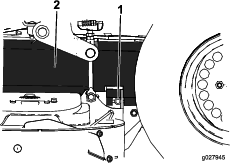
Removing the Sheet-Metal Guard
Loosen the 2 front bolts and remove the sheet-metal guard to access the mower belts and spindles (Figure 31). Place the sheet-metal guard and tighten the bolts after maintenance.

Lubrication
Lubricate the machine when shown on the Check Service Reference Aid decal (Figure 32). Grease more frequently when operating conditions are extremely dusty or sandy.
Grease Type: General-purpose grease.
Greasing the Machine
-
Disengage the PTO, move the motion-control levers to the NEUTRAL-LOCK position, and set the parking brake.
-
Shut off the engine, remove the key, and wait for all moving parts to stop before leaving the operating position.
-
Clean the grease fittings with a rag. Make sure to scrape any paint off the front of the fitting(s).
-
Connect a grease gun to the fitting. Pump grease into the fittings until grease begins to ooze out of the bearings.
-
Wipe up any excess grease.
Greasing the Front Caster Pivots
| Maintenance Service Interval | Maintenance Procedure |
|---|---|
| Yearly |
|
Lubricate the front caster pivots once a year.
-
Remove the dust cap and adjust the caster pivots. Keep the dust cap off until greasing is done. Refer to Adjusting the Caster-Pivot Bearing.
-
Remove the hex plug. Thread a grease fitting into the hole.
-
Pump grease into the fitting until it oozes out around the top bearing.
-
Remove the grease fitting in the hole. Install the hex plug and cap.
Adding Grease
Lubricate the grease fittings as shown on the Check Service Reference Aid decal (Figure 32).
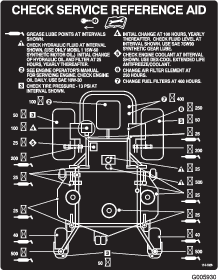
Adding Light Oil or Spray Lubrication
| Maintenance Service Interval | Maintenance Procedure |
|---|---|
| Every 150 hours |
|
Lubricate the machine in the following areas with spray type lubricant or light oil.
-
Seat switch actuator.
-
Brake handle pivot.
-
Brake rod bushings.
-
Motion control bronze bushings.
Greasing the Mower Deck and Belt Idlers
| Maintenance Service Interval | Maintenance Procedure |
|---|---|
| Every 25 hours |
|
Grease with No. 2 lithium or molybdenum grease.
Important: Make sure cutting unit spindles are full of grease weekly.
-
Disengage the PTO, move the motion-control levers to the NEUTRAL-LOCK position, and set the parking brake.
-
Shut off the engine, remove the key, and wait for all moving parts to stop before leaving the operating position.
-
Loosen the bottom bolt holding the mower-deck curtain to the mower deck. Refer to Releasing the Mower-Deck Curtain.
-
Remove the sheet metal guard. Refer to Removing the Sheet-Metal Guard
-
Remove the belt covers and the bolts attached to them.
-
Grease the 3 spindle bearings until grease comes out (Figure 33).
-
Grease the fittings on the push arms (Figure 33).
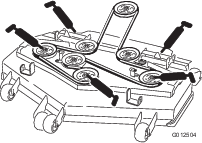
-
Grease the PTO drive belt idler arm (Figure 34).
-
Grease the pump belt idler arm (Figure 34).
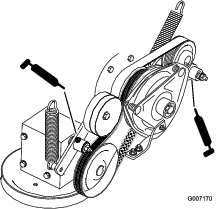
-
Install the belt covers.
-
Install the sheet metal guard. Refer to Removing the Sheet-Metal Guard.
-
Tighten the bolt for the mower-deck curtain. Refer to Releasing the Mower-Deck Curtain.
Engine Maintenance
Servicing the Air Cleaner
Note: Check the filters more frequently if operating conditions are extremely dusty or sandy.
Removing the Air Filter
| Maintenance Service Interval | Maintenance Procedure |
|---|---|
| Every 250 hours |
|
-
Disengage the PTO, move the motion-control levers to the NEUTRAL-LOCK position, and set the parking brake.
-
Shut off the engine, remove the key, and wait for all moving parts to stop before leaving the operating position.
-
Release the latches on the air cleaner and pull the air-cleaner cover off the air-cleaner body (Figure 35).
-
Clean the inside of the air-cleaner cover with compressed air.
-
Gently slide the filter out of the air-cleaner body (Figure 35). Avoid knocking the filter into the side of the body.
-
Inspect the filter for damage by looking into the filter while shining a bright light on the outside of the filter. Holes in the filter appear as bright spots. If the filter is damaged discard it.
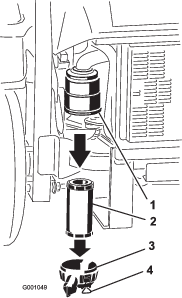
Installing the Air Filter
-
If installing a new filter, check the filter for shipping damage. Do not use a damaged filter.
-
Carefully slide the filter into the filter body (Figure 36). Ensure that it is fully seated by pushing on the outer rim of the filter while installing it.
Important: Do not press on the soft inside area of the filter.
-
Install the air-cleaner cover and secure the latches (Figure 36).

Servicing the Engine Oil
Oil Type: High-quality detergent oil classified API Service CD or higher for diesel engines. Do not use special additives with recommended oils.
Crankcase Capacity: 3.7 L (3.9 US qt)
Viscosity: See the table below:
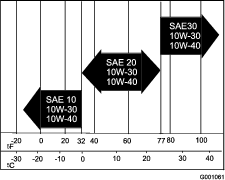
Preparing to Service the Engine Oil
Important: The fasteners for the front engine panel are designed to remain on the machine after cover removal. Loosen all of the fasteners a few turns so that the panel is loose but still attached, then go back and loosen them until the panel comes free. This prevents you from accidentally stripping the bolts free of the retainers.
Tilt the seat forward, loosen the bolts holding the front engine panel and remove it (Figure 38).
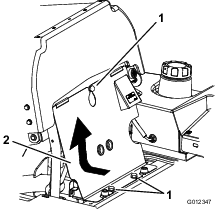
Note: After servicing the engine oil, install the engine panel and tilt the seat into its upright position.
Checking the Engine-Oil Level
| Maintenance Service Interval | Maintenance Procedure |
|---|---|
| Before each use or daily |
|
Note: Check the oil when the engine is cold.
-
Disengage the PTO, move the motion-control levers to the NEUTRAL-LOCK position, and set the parking brake.
-
Shut off the engine, remove the key, and wait for all moving parts to stop before leaving the operating position.
-
Check the engine-oil level (Figure 39).
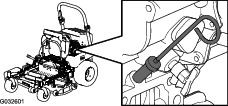
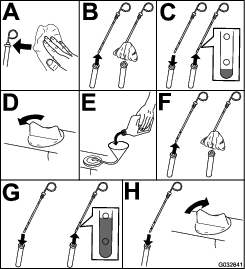
-
Start the engine, run it at idle for 5 minutes, shut off the engine, wait for 3 minutes, and then check the engine-oil level. If needed, add oil up to the FULL mark on the dipstick.
Important: Be sure to keep the engine-oil level between the upper and lower limits on the oil gauge. Engine failure may occur as a result of over filling or under filling the engine oil.
Important: Add the oil very slowly and do not block the opening of the filler hole (Figure 40). If you add oil too fast or block the hole, the oil could back up and foul the air intakes, causing engine damage.

Draining the Engine Oil
| Maintenance Service Interval | Maintenance Procedure |
|---|---|
| After the first 50 hours |
|
| Every 100 hours |
|
-
Start the engine and let it run for 5 minutes.
Note: This warms the oil so it drains better.
-
Park the machine on a level surface, disengage the PTO, move the motion-control levers to the NEUTRAL-LOCK position, and set the parking brake.
-
Shut off the engine, remove the key, and wait for all moving parts to stop before leaving the operating position.
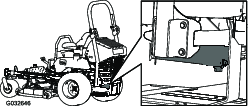
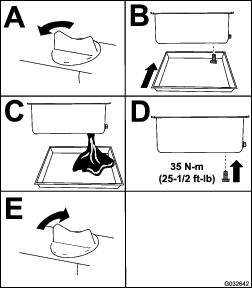
Note: Dispose of the used oil at a recycling center.
Changing the Engine-Oil Filter
| Maintenance Service Interval | Maintenance Procedure |
|---|---|
| After the first 50 hours |
|
| Every 200 hours |
|
-
Drain the oil from the engine; refer to Draining the Engine Oil.
-
Change the engine-oil filter (Figure 42).
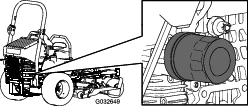
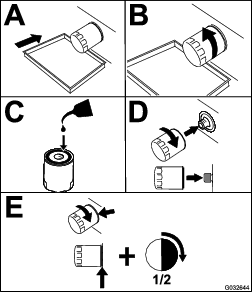
-
Add oil; refer to Checking the Engine-Oil Level.
Fuel System Maintenance
Servicing the Fuel Filter and Water Separator
Draining the Water Separator
| Maintenance Service Interval | Maintenance Procedure |
|---|---|
| Every 40 hours |
|
-
Position the machine on a level surface.
-
Disengage the PTO, move the motion-control levers to the NEUTRAL-LOCK position, and set the parking brake.
-
Shut off the engine, remove the key, and wait for all moving parts to stop before leaving the operating position.
-
Locate the water separator at the back left of the machine.
-
Place a drain pan below the water separator.
-
Open the drain valve on the water separator approximately 1 turn to allow water and other contaminates to drain (Figure 43).
-
Close the drain valve when only diesel fuel comes out (Figure 43).
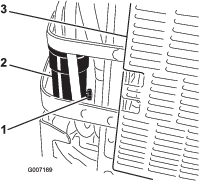
Changing the Fuel Filter
| Maintenance Service Interval | Maintenance Procedure |
|---|---|
| Every 400 hours |
|
Never install a dirty fuel filter if it is removed from the fuel line.
-
Allow the machine to cool down.
-
Disengage the PTO, move the motion-control levers to the NEUTRAL-LOCK position, and set the parking brake.
-
Shut off the engine, remove the key, and wait for all moving parts to stop before leaving the operating position.
-
Close the fuel-shutoff valve(Figure 44).
-
Loosen the 2 hose clamps and disconnect the fuel lines from the fuel filter (Figure 44).
-
Install a new filter. Connect the fuel lines to the fuel filter and install the 2 hose clamps (Figure 44).
-
Open the fuel-shutoff valve.
-
Start the engine and check for leaks.
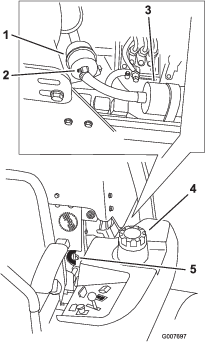
Servicing the Fuel Tank
Do not attempt to drain the fuel tank. Ensure that an Authorized Service Dealer drains the fuel tank and services any components of the fuel system.
Electrical System Maintenance
Servicing the Battery
Warning
Battery posts, terminals, and related accessories contain lead and lead compounds, chemicals known to the State of California to cause cancer and reproductive harm. Wash hands after handling.
Danger
Battery electrolyte contains sulfuric acid which is a deadly poison and causes severe burns.
Do not drink electrolyte and avoid contact with skin, eyes or clothing. Wear safety glasses to shield your eyes and rubber gloves to protect your hands.
Removing the Battery
Warning
Battery terminals or metal tools could short against metal machine components causing sparks. Sparks can cause the battery gasses to explode, resulting in personal injury.
-
When removing or installing the battery, do not allow the battery terminals to touch any metal parts of the machine.
-
Do not allow metal tools to short between the battery terminals and metal parts of the machine.
Warning
Incorrect battery cable routing could damage the machine and cables causing sparks. Sparks can cause the battery gasses to explode, resulting in personal injury.
-
Always disconnect the negative (black) battery cable before disconnecting the positive (red) cable.
-
Always connect the positive (red) battery cable before connecting the negative (black) cable.
-
Disengage the PTO, move the motion-control levers to the NEUTRAL-LOCK position, and set the parking brake.
-
Shut off the engine, remove the key, and wait for all moving parts to stop before leaving the operating position.
-
Unlatch the seat and tilt the seat up.
-
Remove the battery as shown in Figure 49
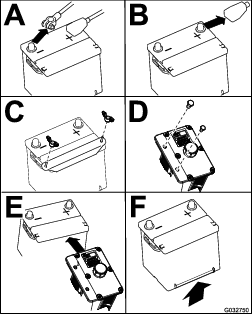
Installing the Battery
Note: Position the battery in the tray with the terminal posts opposite from the hydraulic tank.
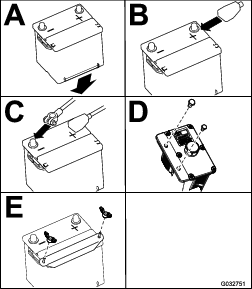
Charging the Battery
Warning
Charging the battery produces gasses that can explode.
Never smoke near the battery and keep sparks and flames away from battery.
Important: Always keep the battery fully charged (1.265 specific gravity). This is especially important to prevent battery damage when the temperature is below 0°C (32°F).
-
Make sure the filler caps are installed in battery. Charge battery for 10 to 15 minutes at 25 to 30A or 30 minutes at 10A.
-
When the battery is fully charged, unplug the charger from the electrical outlet, then disconnect the charger leads from the battery posts (Figure 47).
-
Install the battery in the machine and connect the battery cables, refer to Installing the Battery.
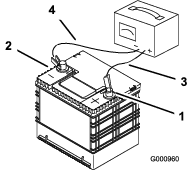
Servicing the Fuses
The electrical system is protected by fuses. It requires no maintenance, however, if a fuse blows check component/circuit for malfunction or short.
Drive System Maintenance
Adjusting the Tracking
The machine has a knob for adjusting the tracking located under the seat.
Important: Adjust the handle neutral and hydraulic pump neutral before adjusting the tracking. Refer toAdjusting the Control Handle Neutral Position and Setting the Hydraulic Pump Neutral Position.
-
Push both control levers forward the same distance.
-
Check if the machine pulls to 1 side. If it does, stop the machine and set the parking brake.
-
Unlatch the seat and tilt the seat forward to access the tracking knob.
Note: Determine the left and right sides of the machine from the normal operating position.
-
To make the machine go right, turn the knob toward the right side of the machine. Refer to Figure 49.
-
To make the machine go left, turn the knob toward the left side of the machine. Refer to Figure 49.
-
Repeat adjustment until the tracking is correct.
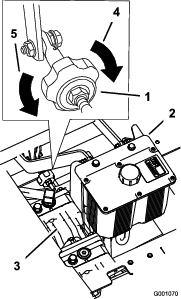
Checking the Tire Pressure
| Maintenance Service Interval | Maintenance Procedure |
|---|---|
| Every 50 hours |
|
Maintain the air pressure in the rear tires at 90 kPa (13 psi). Uneven tire pressure can cause uneven cut. Check the tires when they are cold to get the most accurate pressure reading.
Note: The front tires are semi-pneumatic tires and do not require air pressure maintenance.

Checking the Wheel Lug Nuts
| Maintenance Service Interval | Maintenance Procedure |
|---|---|
| After the first 100 hours |
|
| Every 500 hours |
|
Check and torque the wheel lug nuts to 122 to 129 N∙m (90 to 95 ft-lb).
Checking the Wheel-Hub Slotted Nut
| Maintenance Service Interval | Maintenance Procedure |
|---|---|
| After the first 100 hours |
|
| Every 500 hours |
|
The slotted nut needs to be torqued to 170 N∙m (125 ft-lb).
-
Disengage the PTO, move the motion-control levers to the NEUTRAL-LOCK position, and set the parking brake.
-
Shut off the engine, remove the key, and wait for all moving parts to stop before leaving the operating position.
-
Remove the cotter pin.
-
Torque the slotted nut to 170 N∙m (125 ft-lb) (Figure 51).
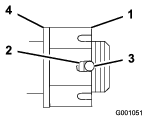
-
Check the distance from bottom of slot in nut to inside edge of hole. 2 threads or less should be showing (Figure 51).
-
If more than 2 threads are showing remove nut and install washer between hub and nut.
-
Torque the slotted nut to 170 N∙m (125 ft-lb) (Figure 51).
-
Tighten the nut until the next set of slots line up with the hole in the shaft (Figure 51).
-
Replace the cotter pin.
Adjusting the Caster-Pivot Bearing
| Maintenance Service Interval | Maintenance Procedure |
|---|---|
| Every 500 hours |
|
-
Disengage the PTO, move the motion-control levers to the NEUTRAL-LOCK position, and set the parking brake.
-
Shut off the engine, remove the key, and wait for all moving parts to stop before leaving the operating position.
-
Remove the dust cap from caster and tighten the locknut (Figure 52).
-
Tighten the locknut until the spring washers are flat and then back off a 1/4 turn to properly set the pre-load on the bearings (Figure 52).
Important: Make sure spring washers are installed correctly as shown in Figure 52.
-
Install the dust cap (Figure 52).
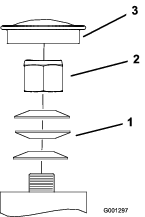
Servicing the Gearbox
Checking the Gearbox-Oil Level
| Maintenance Service Interval | Maintenance Procedure |
|---|---|
| Every 100 hours |
|
Use SAE 75W–90 Synthetic Gear Lube.
-
Park the machine on a level surface.
-
Disengage the PTO, move the motion-control levers to the NEUTRAL-LOCK position, and set the parking brake.
-
Shut off the engine, remove the key, and wait for all moving parts to stop before leaving the operating position.
-
Remove the side or rear plug on the gearbox (Figure 53).
-
The oil should be up to the opening of the gearbox.
-
Add oil if needed to bring it to the correct level.
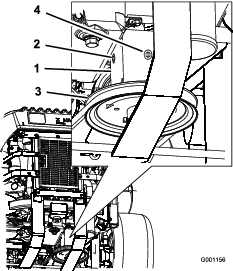
Changing the Gearbox Oil
| Maintenance Service Interval | Maintenance Procedure |
|---|---|
| After the first 100 hours |
|
| Yearly |
|
Contact an Authorized Service Dealer to change the gearbox oil.
Adjusting the Electric Clutch
| Maintenance Service Interval | Maintenance Procedure |
|---|---|
| Every 500 hours |
|
The clutch is adjustable to ensure proper engagement and proper braking.
-
Disengage the PTO, move the motion-control levers to the NEUTRAL-LOCK position, and set the parking brake.
-
Shut off the engine, remove the key, and wait for all moving parts to stop before leaving the operating position.
-
Unlatch the seat and tip it forward.
-
Loosen the front engine panel knobs and remove the panel.
-
Pull up on the spring loaded idler pulley for the PTO drive belt and remove the belt from the clutch pulley (Figure 54).
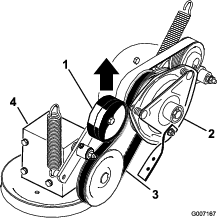
-
Unplug the electric connection for the clutch (Figure 55).
-
Remove the bolts holding the rubber clutch strap to the mower frame (Figure 55).
-
Remove the center bolt holding the clutch to the engine shaft and remove the clutch and key (Figure 55).
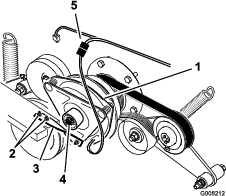
-
Insert a 0.381 to 0.533 mm (0.015 to 0.021 inch) feeler gauge through 1 inspection slot in the side of the assembly. Make sure it is between the armature and the rotor friction surfaces (Figure 56).
-
Tighten the locknuts until there is slight binding on the feeler gauge but it can be moved easily within the air gap (Figure 56).
-
Repeat this for the remaining slots.
-
Check each slot again and make slight adjustments until the feeler gauge between the rotor and armature has very slight contact between them.
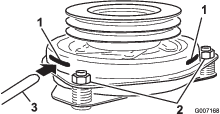
-
Install the clutch to the engine shaft with the key.
-
Apply thread-locking adhesive to the center bolt.
-
While holding the crank shaft at the back of the machine, install the center bolt and torque it to 68 N∙m (50 ft-lb) (Figure 55).
-
Install the rubber clutch strap to the mower frame with the 2 previously removed bolts and nuts (Figure 55).
-
Pull up on the spring loaded idler for the PTO drive belt and install it onto the clutch pulley (Figure 54).
-
Plug in the electric connection for the clutch (Figure 55).
-
Install the front engine panel and tighten the knobs.
-
Lower down the seat.
Cooling System Maintenance
Servicing the Cooling System
Danger
Discharge of hot pressurized coolant or touching hot radiator and surrounding parts can cause severe burns.
-
Do not remove the radiator cap when the engine is hot. Always allow the engine to cool at least 15 minutes or until the radiator cap is cool enough to touch without burning your hand before removing the radiator cap.
-
Do not touch radiator and surrounding parts that are hot.
Danger
Rotating shaft and fan can cause personal injury.
-
Do not operate the machine without the covers in place.
-
Keep fingers, hands and clothing clear of rotating fan and drive shaft.
-
Shut off the engine and remove the ignition key before performing maintenance.
Caution
Swallowing engine coolant can cause poisoning.
-
Do not swallow engine coolant.
-
Keep out of reach from children and pets.
Checking the Engine Coolant Level
| Maintenance Service Interval | Maintenance Procedure |
|---|---|
| After the first 8 hours |
|
| Before each use or daily |
|
| Every 100 hours |
|
Fluid Type: 50/50 mix of extended life antifreeze and water
Cooling System Capacity: 4.6 L (176 oz)
Note: Do not open the radiator cap. Doing this may induce air into the cooling system.
-
Position the machine on a level surface, shut off the engine, and set the parking brake.
-
Unlatch the seat and tilt the seat up.
-
With the engine cool, check the overflow bottle level. The fluid needs to be up to the bump on the outside of the overflow bottle (Figure 57).
-
If the coolant level is low, add a 50/50 mix of extended life antifreeze and water to the overflow bottle (Figure 57).
-
Add the 50/50 coolant mix to the overflow bottle and fill it to the indicator line on the bottle (Figure 57).
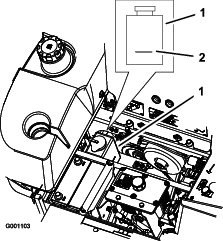
Cleaning the Engine-Oil Cooler and Radiator Screen
| Maintenance Service Interval | Maintenance Procedure |
|---|---|
| Before each use or daily |
|
Before each use, check and clean the radiator screen and oil cooler. Remove any build-up of grass, dirt or other debris from the oil cooler and radiator screen with compressed air (Figure 58).
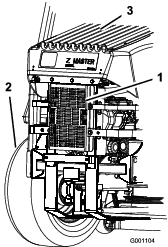
Changing the Engine Coolant
| Maintenance Service Interval | Maintenance Procedure |
|---|---|
| Yearly |
|
Have an Authorized Service Dealer change the engine coolant every year.
Brake Maintenance
Adjusting the Parking Brake
| Maintenance Service Interval | Maintenance Procedure |
|---|---|
| Every 25 hours |
|
| Every 200 hours |
|
-
Engage the parking brake.
-
Measure the length of the spring. Measurement should be 64 mm (2-1/2 inches) between the washers (Figure 59).
-
If adjustment is necessary, release the parking brake, loosen the jam nut below the spring and adjust the nut directly below the spring (Figure 59). Turn the nut until the correct measurement is obtained. Turn the nut clockwise to shorten spring length and turn counter-clockwise to lengthen the spring.
-
Tighten the 2 nuts together.
-
Engage the parking brake. Check the measurement of the spring again.
-
If adjustment is necessary, repeat the procedures above.
-
Repeat on the opposite side of machine.

Belt Maintenance
Inspecting the Belts
| Maintenance Service Interval | Maintenance Procedure |
|---|---|
| Every 100 hours |
|
Check the belts for squealing when the belt is rotating, blades slipping when cutting grass, frayed belt edges, burn marks and cracks are signs of a worn mower belt. Replace damaged belts.
Replacing the Mower Belt
Important: The fasteners on the covers of this machine are designed to remain on the cover after removal. Loosen all of the fasteners on each cover a few turns so that the cover is loose but still attached, then go back and loosen them until the cover comes free. This prevents you from accidentally stripping the bolts free of the retainers.
The signs of a worn mower belt are squealing while the belt is rotating, blades slipping while you are cutting grass, frayed belt edges, burn marks, and cracks. Replace the mower belt if you detect any of these signs.
-
Disengage the PTO, move the motion-control levers to the NEUTRAL-LOCK position, and set the parking brake.
-
Shut off the engine, remove the key, and wait for all moving parts to stop before leaving the operating position.
-
Loosen the bottom bolt holding the mower-deck curtain to the mower deck. Refer to Releasing the Mower-Deck Curtain.
-
Remove the sheet metal guard. Refer to Removing the Sheet-Metal Guard
-
Remove the belt covers and the bolts attached to them.
-
Loosen the fixed idler arm and adjust it to relieve belt tension (Figure 60).
-
Remove the old belt.
-
Install the new belt on the pulleys.
-
Insert a ratchet with a short extension or a breaker bar into the square hole in the fixed idler arm (Figure 60).
-
Adjust the mower deck to the 76 mm (3 inch) height-of-cut position.
-
To increase the belt tension, rotate the ratchet or breaker bar counterclockwise to move the fixed idler arm until there is 16.5 cm (6-1/2 inches) between the spring hooks (Figure 60).
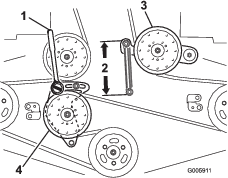
-
While holding the belt in tension, tighten the 2 bolts that secure the fixed idler arm.
-
Remove the ratchet or breaker bar from the square hole in the fixed idler arm.
-
Install the belt covers with the tabs in the slots. Install the screws and close the latches (Figure 61).
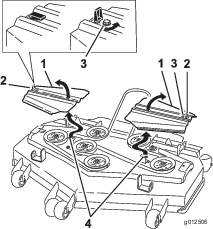
-
Install the sheet metal guard. Refer to Removing the Sheet-Metal Guard.
-
Tighten the bolt for the mower-deck curtain. Refer to Releasing the Mower-Deck Curtain.
-
Check the tension on the drive belts.
Replacing the PTO Drive Belt
| Maintenance Service Interval | Maintenance Procedure |
|---|---|
| Every 50 hours |
|
Important: The fasteners for the front engine panel are designed to remain on the machine after cover removal. Loosen all of the fasteners a few turns so that the panel is loose but still attached, then go back and loosen them until the panel comes free. This prevents you from accidentally stripping the bolts free of the retainers.
Squealing when the belt is rotating, blades slipping when cutting grass, frayed belt edges, burn marks, and cracks are signs of a worn PTO belt. Replace the mower belt if any of these conditions are evident.
-
Disengage the PTO, move the motion-control levers to the NEUTRAL-LOCK position, and set the parking brake.
-
Shut off the engine, remove the key, and wait for all moving parts to stop before leaving the operating position.
-
Tilt the seat forward, loosen the bolts, and remove the front engine panel (Figure 62).

-
Remove the spring from the idler arm (Figure 63).
-
Remove the clutch stop bracket.
-
Remove the old PTO drive belt.
-
Install the PTO drive belt around the clutch pulley and the gearbox pulley (Figure 63).
-
Intall the clutch stop bracket.
-
Install the spring to the idler arm (Figure 63).
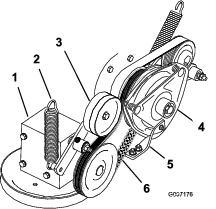
Replacing the Pump Drive Belt
| Maintenance Service Interval | Maintenance Procedure |
|---|---|
| Every 50 hours |
|
Note: Remove the PTO drive belt first if the pump drive belt needs to be replaced.
Replacing and Tensioning the Alternator Belt
Replacing the Alternator Belt
| Maintenance Service Interval | Maintenance Procedure |
|---|---|
| Every 50 hours |
|
If the alternator belt needs to be replace, take your machine to an Authorized Service Dealer.
Tensioning the Alternator Belt
-
Place a handle between the alternator and cylinder block.
-
Adjust the alternator to the outside until there is 7 to 9 mm (1/4 to 11/32 inch) deflection in the belt between the engine and the alternator pulleys with 10 kgf (22.1 lb of force) (Figure 65).
-
Tighten the alternator bolts.
-
Check the deflection in the belt again and adjust the belt if needed.
-
If the deflection is correct, tighten the bottom and upper bolt (Figure 65).
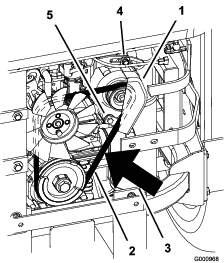
Controls System Maintenance
Adjusting the Control Handle Neutral Position
If the motion-control levers do not align, or move easily into the console notch, adjustment is required. Adjust each lever, spring and rod separately.
Note: The motion-control levers must be installed correctly. See Installing the Motion Control Levers in the set up instructions.
-
Disengage the PTO, move the motion-control levers to the NEUTRAL-LOCK position, and set the parking brake.
-
Shut off the engine, remove the key, and wait for all moving parts to stop before leaving the operating position.
-
Unlatch the seat and tilt the seat forward.
-
Begin with either the left or right motion-control lever.
-
Move the lever to the neutral position but not locked (Figure 66).
-
Pull the lever back until the clevis pin (on arm below pivot shaft) contacts the end of the slot (just beginning to put pressure on the spring) (Figure 66).
-
Check where the control lever is relative to notch in console (Figure 66). It should be centered allowing lever to pivot outward to the NEUTRAL-LOCK position.
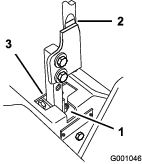
-
If adjustment is needed, loosen the nut and jam nut against the yoke (Figure 67).
-
Apply slight rearward pressure on the motion-control lever, turn the head of the adjustment bolt in the appropriate direction until the control lever is centered in the NEUTRAL-LOCK position (Figure 67).
Note: Keep rearward pressure on the lever to keep the pin at the end of the slot and to allow the adjustment bolt to move the lever to the appropriate position.
-
Tighten the nut and jam nut (Figure 67).
-
Repeat for the opposite side of the machine.
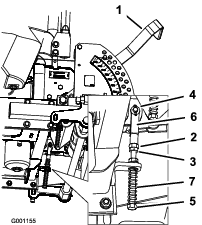
Hydraulic System Maintenance
Servicing the Hydraulic System
Hydraulic Oil Type: Toro® HYPR-OIL™ 500 hydraulic oil or Mobil® 1 15W-50 oil
Hydraulic System Oil Capacity: 3.9 L (132 oz)
Important: Use oil specified. Other fluids could cause system damage.
Checking the Hydraulic Fluid Level
| Maintenance Service Interval | Maintenance Procedure |
|---|---|
| After the first 8 hours |
|
| Every 25 hours |
|
Note: There are 2 ways of checking the hydraulic oil. 1 is when the oil is warm and 1 is when the oil is cold. The baffle inside the tank has 2 levels depending if the oil is warm or cold.
-
Position the machine on a level surface and set the parking brake.
-
Clean the area around filler neck of hydraulic tank (Figure 68).
-
Remove the cap from the filler neck. Look inside to check if there is fluid in the reservoir (Figure 68).
-
If there is no fluid, add fluid to the reservoir until it reaches the cold level of the baffle.
-
Run the machine at low idle for 15 minutes to allow any air to purge out of the system and warm the fluid. Refer to Starting and Stopping the Engine.
-
Recheck the fluid level while the fluid is warm. The fluid should be between cold and hot.
-
If required, add fluid to the hydraulic tank.
Note: The fluid level should be to the top of the hot level of the baffle, when the fluid is hot (Figure 68).
-
Install the cap on the filler neck.
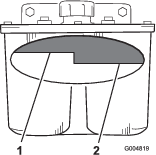
Warning
Hydraulic fluid escaping under pressure can penetrate skin and cause injury.
-
If hydraulic fluid is injected into the skin it must be surgically removed within a few hours by a doctor familiar with this type of injury. Gangrene may result if this is not done.
-
Keep body and hands away from pin hole leaks or nozzles that eject high-pressure hydraulic fluid.
-
Use cardboard or paper to find hydraulic leaks.
-
Safely relieve all pressure in the hydraulic system before performing any work on the hydraulic system.
-
Make sure all hydraulic-fluid hoses and lines are in good condition and all hydraulic connections and fittings are tight before applying pressure to hydraulic system.
-
Replacing the Hydraulic Filter and Oil
| Maintenance Service Interval | Maintenance Procedure |
|---|---|
| After the first 25 hours |
|
| Every 250 hours |
|
| Every 500 hours |
|
Use summer filter above 0°C (32°F).
Use winter filter below 0°C (32°F).
-
Disengage the PTO, move the motion-control levers to the NEUTRAL-LOCK position, and set the parking brake.
-
Shut off the engine, remove the key, and wait for all moving parts to stop before leaving the operating position.
Important: Do not substitute automotive oil filter or severe hydraulic system damage may result.
-
Place a drain pan under the filter, remove the old filter, and wipe the filter adapter gasket surface clean (Figure 69).
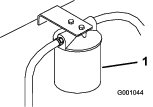
-
Remove the right-hand hydraulic line that comes into the adapter (Figure 70).
-
Allow the oil to drain out of the system into the drain pan.
-
Install the right-hand hydraulic line to the adapter (Figure 70).
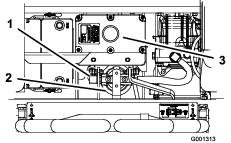
-
Apply a thin coat to the rubber gasket on the replacement filter (Figure 71).
-
Install the replacement hydraulic filter onto the filter adapter. Do not tighten.
-
Fill the hydraulic tank with hydraulic fluid until the fluid overflows the filter and then turn the oil filter clockwise until the rubber gasket contacts the filter adapter, then tighten the filter an additional 1/2 turn (Figure 71).
-
Clean up any spilled fluid.
-
Add fluid to the cold level of the baffle in the hydraulic tank.
-
Start the engine and let it run for about 2 minutes to purge air from the system. Shut off the engine and check for leaks. If 1 or both wheels do not drive, refer to Bleeding the Hydraulic System.
-
Recheck the fluid level while the fluid is warm. The fluid should be between cold and hot.
-
If required, add fluid to the hydraulic tank. Do not overfill.
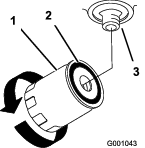
Bleeding the Hydraulic System
The traction system is self bleeding, however, it may be necessary to bleed the system if fluid is changed or after work is performed on the system.
-
Raise the rear of the machine so wheels are off the ground and support it with jack stands.
-
Start the engine and run at low idle speed. Engage the lever and traction on 1 side and spin the wheel by hand.
-
When the wheel begins to spin on its own, keep it engaged until wheel drives smoothly (minimum 2 minutes).
-
Check hydraulic-fluid level and add as required to maintain proper level.
-
Repeat this procedure on the opposite wheel.
Checking the Hydraulic Hoses
| Maintenance Service Interval | Maintenance Procedure |
|---|---|
| Every 100 hours |
|
Check the hydraulic hoses for leaks, loose fittings, kinked lines, loose mounting supports, wear, weather and chemical deterioration. Make necessary repairs before operating.
Note: Keep areas around the hydraulic system clean from grass and debris build up.
Setting the Hydraulic Pump Neutral Position
Note: Adjust the handle neutral first. That needs to be correct before you can make the following adjustments.
This adjustment must be made with drive wheels turning.
Danger
Mechanical or hydraulic jacks may fail to support machine and cause a serious injury.
-
Use jack stand when supporting machine.
-
Do not use hydraulic jacks.
Warning
Engine must be running so motion control adjustment can be performed. Contact with moving parts or hot surfaces may cause personal injury.
Keep your hands, feet, face, clothing and other body parts away from rotating parts, muffler and other hot surfaces.
-
Raise the frame and block up the machine so drive wheels can rotate freely.
-
Disconnect the electrical connector from the seat safety switch. Temporarily install a jumper wire across terminals in the wiring harness connector.
-
Unlatch the seat and slide seat forward.
-
Disconnect the seat rod and tilt the seat fully forward.
Setting the Right Hydraulic Pump Neutral Position
-
Start the engine, open the throttle 1/2 way, and release parking brake; refer to Starting and Stopping the Engine.
Note: The motion-control lever must be in the NEUTRAL position while making any adjustments.
-
Adjust the pump rod length by rotating the knob, in the appropriate direction, until the wheel is still or slightly creeping in reverse (Figure 72).
-
Move the motion-control lever forward and reverse, then back to neutral. The wheel must stop turning or slightly creep in reverse.
-
Open the throttle to the FAST position. Make sure wheel remains stopped or slightly creeps in reverse, adjust if necessary.

Setting the Left Hydraulic Pump Neutral Position
-
Loosen the locknuts at the ball joints on the pump control rod (Figure 73).
-
Start the engine, open throttle 1/2 way, and release parking brake. Refer to Starting and Stopping the Engine
Note: The motion-control lever must be in neutral while making any adjustments.
Note: The front nut on the pump rod has left-hand threads.
-
Adjust the pump rod length by rotating double nuts on rod, in the appropriate direction, until wheel is still or slightly creeps in reverse (Figure 73).
-
Move the motion-control lever forward and reverse, then back to neutral. The wheel must stop turning or slightly creep in reverse.
-
Open the throttle to fast. Make sure the wheel remains stopped or slightly creeps in reverse, adjust if necessary.
-
Tighten the locknuts at the ball joints (Figure 73).
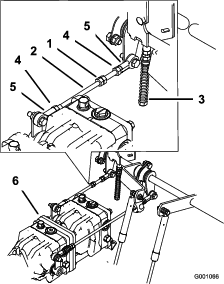
Warning
Electrical system does not perform proper safety shut off with jumper wire installed.
-
Remove jumper wire from wire harness connector and plug connector into seat switch when adjustment is completed.
-
Never operate this unit with jumper installed and seat switch bypassed.
-
-
After both pump neutrals are set, shut off the machine.
-
Remove the jumper wire from the wire harness connector and plug the connector into the seat switch.
-
Install the seat rod and lower the seat into position.
-
Remove the jack stands.
Mower Deck Maintenance
Leveling the Mower
Setting Up the Machine
-
Position the mower on a flat surface.
-
Disengage the PTO, move the motion-control levers to the NEUTRAL-LOCK position, and set the parking brake.
-
Shut off the engine, remove the key, and wait for all moving parts to stop before leaving the operating position.
-
Check tire pressure of all 4 tires. If needed, adjust the pressure to 90kPa (13 psi).
-
Lower the mower to the 76 mm (3 inch) height-of-cut position.
-
Inspect the 4 chains. The chains need to have tension.
-
If 1 rear chain is loose, lower (loosen) the front-support arm on the same side. Refer to Adjusting the Front-to-Rear Mower Pitch.
-
If 1 front chain is loose, raise (tighten) the front-support arm for that chain. Refer to Adjusting the Front-to-Rear Mower Pitch.
Leveling the Mower Side-to-Side
-
Position the right blade front-to-rear (Figure 74).
-
Measure the right blade at the B location, from a level surface to the cutting edge of the blade tip (Figure 74).
-
Record this measurement. This measurement needs to be 7.9 to 8.3 cm (3-1/8 to 3-1/4 inches).
-
Position the left blade front-to-rear (Figure 74).
-
Measure the left blade at the C location (Figure 74), from a level surface to the cutting edge of the blade tip .
-
Record this measurement. This measurement needs to be 7.9 to 8.3 cm (3-1/8 to 3-1/4 inches).
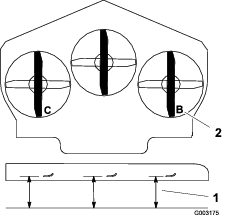
-
If the measurements at positions B or C are not correct, loosen the bolt attaching the rear chain to the rear-support arm (Figure 75).
-
Loosen the jam nut under the rear-support arm and adjust the adjustment bolt to get a measurement of 7.9 to 8.3 cm (3-1/8 to 3-1/4 inches) (Figure 75).
Note: It is recommended that both sides of the mower are adjusted the same distance.
-
Tighten the jam nut under the rear-support arm and tighten the bolt securing the chain to the rear-support arm.
-
Adjust the opposite side if needed.
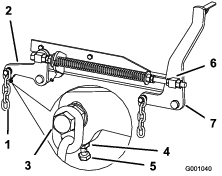
Adjusting the Front-to-Rear Mower Pitch
-
Position the right blade front-to-rear (Figure 76).
-
Measure the right blade at the A location, from a level surface to the cutting edge of the blade tip (Figure 76).
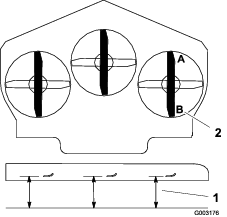
-
Record this measurement.
-
Measure the right blade at the B location, from a level surface to the cutting edge of the blade tip (Figure 76).
-
Record this measurement.
-
The mower blade should be 6 to 10 mm (1/4 to 3/8 inch) lower at position A than at position B (Figure 76). If it is not correct, proceed to the following steps.
Note: Both of the front swivels need to be adjusted the same amount to maintain equal chain tension.
-
Loosen the front swivel jam nuts, at the front of the right and left swivels, approximately a 13 mm (1/2 inch) (Figure 75).
-
Adjust the lift nuts on both the left and the right side of the machine to achieve 6 to 10 mm (1/4 to 3/8 inch) lower in front at A than in the rear at B (Figure 75).
-
Tighten both swivel jam nuts against the front swivel to lock the height.
-
Check to make sure there is equal tension on the chains and adjust again if needed.
Adjusting the Compression Spring
-
Raise the mower lift lever to the transport position.
-
Check the distance between the 2 large washers, it needs to be 29.2 cm (11-1/2 inches) (Figure 77).
-
Adjust this distance, by loosening the spring-jam nut and turning the nut in front of each spring (Figure 77). If you turn the nut clockwise the spring shortens; counter-clockwise lengthens the spring.
-
Lock the nut into position by tightening the spring-jam nut (Figure 77).
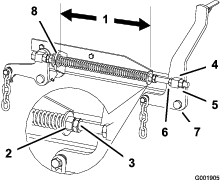
Servicing the Cutting Blades
Maintain sharp blades throughout the cutting season because sharp blades cut cleanly without tearing or shredding the grass blades. Tearing and shredding turns grass brown at the edges, which slows growth and increases the chance of disease.
Check the cutter blades daily for sharpness, and for any wear or damage. File down any nicks and sharpen the blades as necessary. If a blade is damaged or worn, replace it immediately with a genuine Toro replacement blade. For convenient sharpening and replacement, you may want to keep extra blades on hand.
Danger
A worn or damaged blade can break, and a piece of the blade could be thrown into the operator's or bystander's area, resulting in serious personal injury or death.
-
Inspect the blade periodically for wear or damage.
-
Replace a worn or damaged blade.
Before Inspecting or Servicing the Blades
-
Park the machine on a level surface, disengage the blade control (PTO), and set the parking brake.
-
Turn the ignition key to OFF and remove the key.
-
Disconnect the spark-plug wire(s) from the spark plug(s).
Inspecting the Blades
| Maintenance Service Interval | Maintenance Procedure |
|---|---|
| Before each use or daily |
|
-
Inspect the cutting edges (Figure 78).
If the edges are not sharp or have nicks, remove and sharpen the blades. Refer to Sharpening the Blades.
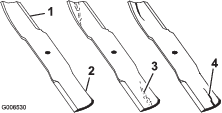
-
Inspect the blades, especially the curved area (Figure 78).
If you notice any damage, wear, or a slot forming in this area (Figure 78), immediately install a new blade.
Checking for Bent Blades
-
Disengage the PTO, move the motion-control levers to the NEUTRAL-LOCK position, and set the parking brake.
-
Shut off the engine, remove the key, and wait for all moving parts to stop before leaving the operating position.
-
Rotate the blades until the ends face forward and backward (Figure 79). Measure from a level surface to the cutting edge, position A, of the blades (Figure 79). Note this dimension.
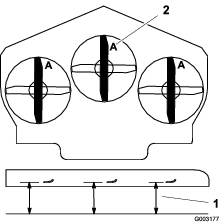
-
Rotate the opposite ends of the blades forward.
-
Measure from a level surface to the cutting edge of the blades at the same position as in step 3 above. The difference between the dimensions obtained in steps 3 and 4 must not exceed 3 mm (1/8 inch). If this dimension exceeds 3 mm (1/8 inch), the blade is bent and must be replaced; refer to Removing the Blades and Installing the Blades.
Warning
A blade that is bent or damaged could break apart and could seriously injure or kill you or bystanders.
-
Always replace bent or damaged blade with a new blade.
-
Never file or create sharp notches in the edges or surfaces of blade.
-
Removing the Blades
Blades must be replaced if a solid object is hit, if the blade is out of balance or is bent. To ensure optimum performance and continued safety conformance of the machine, use genuine Toro replacement blades. Replacement blades made by other manufacturers may result in non-conformance with safety standards.
Warning
Contact with a sharp blade can cause serious injury.
Wear gloves or wrap sharp edges of the blade with a rag.
-
Hold the blade end using a rag or thickly padded glove.
-
Remove the blade bolt, spring disk and blade from the spindle shaft (Figure 82).
Sharpening the Blades
Warning
When sharpening blade, pieces of blade could be thrown and cause serious injury.
Wear proper eye protection when sharpening blade.
-
Use a file to sharpen the cutting edge at both ends of the blade (Figure 80). Maintain the original angle. The blade retains its balance if the same amount of material is removed from both cutting edges.

-
Check the balance of the blade by putting it on a blade balancer (Figure 81). If the blade stays in a horizontal position, the blade is balanced and can be used. If the blade is not balanced, file some metal off the end of the sail area only (Figure 82). Repeat this procedure until the blade is balanced.

Installing the Blades
-
Install the blade onto the spindle shaft (Figure 82).
Important: The curved part of the blade must be pointing upward toward the inside of the mower to ensure proper cutting.
-
Install the curved washer and blade bolt. The curved washer cone must be installed toward the bolt head (Figure 82). Torque the blade bolt to 115 to 150 N∙m (85 to 110 ft-lb).
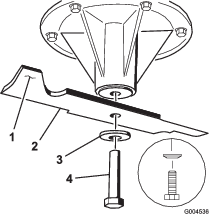
Cleaning
Cleaning under the Mower
| Maintenance Service Interval | Maintenance Procedure |
|---|---|
| Before each use or daily |
|
Remove the grass buildup under the mower daily.
-
Disengage the PTO, move the motion-control levers to the NEUTRAL-LOCK position, and set the parking brake.
-
Shut off the engine, remove the key, and wait for all moving parts to stop before leaving the operating position.
-
Raise the mower to the transport position.
Disposing of Waste
Engine oil, batteries, hydraulic oil, and engine coolant are pollutants to the environment. Dispose of these according to your state and local regulations.
Storage
Cleaning and Storage
-
Disengage the power takeoff (PTO), set the parking brake, and turn the ignition key to the OFF position. Remove the key.
-
Remove grass clippings, dirt, and grime from the external parts of the entire machine, especially the engine and hydraulic system. Clean dirt and chaff from the outside of the engine cylinder head fins and blower housing.
Important: You can wash the machine with mild detergent and water. Do not pressure wash the machine. Avoid excessive use of water, especially near the control panel, engine, hydraulic pumps, and motors.
-
Check the brake; refer to Adjusting the Parking Brake.
-
Service the air cleaner; refer toServicing the Air Cleaner.
-
Grease the machine; refer to Lubrication.
-
Change the crankcase oil; refer to Servicing the Engine Oil.
-
Check the tire pressure; refer to Checking the Tire Pressure.
-
Change the hydraulic filter; refer to Replacing the Hydraulic Filter and Oil.
-
Charge the battery; refer to Charging the Battery.
-
Scrape any heavy buildup of grass and dirt from the underside of the mower, then wash the mower with a garden hose.
Note: Run the machine with the PTO engaged and the engine at high idle for 2 to 5 minutes after washing.
-
Check the condition of the blades; refer to Servicing the Cutting Blades.
-
Prepare the machine for storage when non-use occurs over 30 days. Prepare the machine for storage as follows:
-
Add a petroleum based stabilizer/conditioner to fuel in the tank. Follow mixing instructions from the stabilizer manufacturer. Do not use an alcohol based stabilizer (ethanol or methanol).
Note: A fuel stabilizer/conditioner is most effective when mixed with fresh fuel and used at all times.
-
Run the engine to distribute conditioned fuel through the fuel system (5 minutes).
-
Shut off the engine, allow it to cool, and drain the fuel tank; refer to Servicing the Fuel Tank.
-
Restart the engine and run it until it stops.
-
Dispose of fuel properly. Recycle as per local codes.
Important: Do not store stabilizer/conditioned fuel over 90 days.
-
-
Check and tighten all bolts, nuts, and screws. Repair or replace any part that is damaged.
-
Paint all scratched or bare metal surfaces. Paint is available from your Authorized Service Dealer.
-
Store the machine in a clean, dry garage or storage area. Remove the key from the ignition switch and keep it out of reach of children or other unauthorized users. Cover the machine to protect it and keep it clean.
Troubleshooting
| Problem | Possible Cause | Corrective Action |
|---|---|---|
| The starter does not crank. |
|
|
| The engine does not start, starts hard, or fails to keep running. |
|
|
| The engine loses power. |
|
|
| The engine overheats. |
|
|
| The machine does not drive. |
|
|
| The machine has abnormal vibration. |
|
|
| The cutting height is uneven. |
|
|
| The cutting blades do not rotate. |
|
|
Schematics
Wire Diagram
